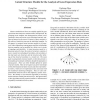Free Online Productivity Tools
i2Speak
i2Symbol
i2OCR
iTex2Img
iWeb2Print
iWeb2Shot
i2Type
iPdf2Split
iPdf2Merge
i2Bopomofo
i2Arabic
i2Style
i2Image
i2PDF
iLatex2Rtf
Sci2ools
CSB
2003
IEEE
2003
IEEE
Latent Structure Models for the Analysis of Gene Expression Data
Cluster methods have been successfully applied in gene expression data analysis to address tumor classification. By grouping tissue samples into homogeneous subsets, more systematic characterization can be developed and new subtypes of tumors be discovered. Central to cluster analysis is the notion of similarity between the individual samples. In this paper, we propose latent structure models as a framework where dependence among genes and thus relationship between samples can be modelled in a better way in terms of topology and flexibility. A latent structure model is a Bayesian network where the network structure contains at least a rooted tree including all variables, only variables at the leaf nodes are observed, and the structure after deleting all the observed variables is a rooted tree. The main gain in using latent structure models is that they provide a principled and systematic method to handle the dependence among genes. There are other benefits offered by latent structu...
| Added | 04 Jul 2010 |
| Updated | 04 Jul 2010 |
| Type | Conference |
| Year | 2003 |
| Where | CSB |
| Authors | Dong Hua, Dechang Chen, Xiuzhen Cheng, Abdou Youssef |
Comments (0)

